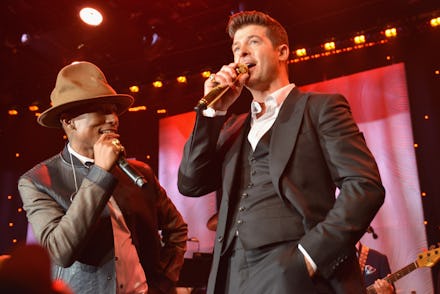The Wild "Blurred Lines" Trial Proves One Essential Truth About Music

The dramatic "Blurred Lines" trial is expected to wrap up Friday in Los Angeles after two weeks of deliberation and crazy courtroom antics. Though pop songs often fade quickly, "Blurred Lines" has been having an eternal moment since the family of late R&B singer Marvin Gaye alleged that Robin Thicke, Pharrell and T.I.'s 2013 song stole elements from Gaye's 1977 hit "Got to Give It Up." The trial has been a wild ride, and a jury will decide whether the Gaye estate receives an astounding $25 million in damages on a song that made well over $16 million.
Whether or not the Gayes reap their reward, this trial has done the music world an unexpected service. It has demonstrated in blazing, hilarious technicolor detail just how hard it is to describe music — how impossible it is to define what makes a song and, therefore, how hard it is to prove when a song is stolen. It's a trial about blurred lines, through and through.
Wild times: The trial and deposition are ripped straight from the script of a soap opera. Thicke claimed he was so messed up on vodka and Vicodin during the "Blurred Lines" media blitz that he incorrectly claimed to have modeled the song after "Got to Give It Up." He said he didn't actually write the song, either; he was jealous of Pharrell, so he took credit. Pharrell said he didn't steal from Gaye, but respected him because Gaye was "an Aries."
But the wildest moments have come from efforts to prove or disprove the songs' similarity. Thicke took the stand last week and played a medley of songs — Michael Jackson's "Man in the Mirror," U2's "With or Without You," the Beatles' "Let It Be," Bob Marley's "No Woman No Cry" and Alphaville's "Forever Young" — to prove that many songs have similar characteristics, but similarities don't necessarily constitute stealing. In short, he played this Axis of Awesome medley:
He's onto something. The absurdity of Thicke's piano demonstration caught on like wildfire in the media. Thicke might be a scumbag, but he's got a point: Trying to pin down the specifics of a song is like trying to hold a fish. As soon as you think you've got it, it slips out of your grasp. Songs are difficult to compare because of their intangible character — perhaps the very thing that makes them feel so special to listeners. Copyright infringement claims, whether in court or not, are commonplace (Vanilla Ice v. David Bowie and Queen, Michael Bolton v. the Isley Brothers, Sam Smith and Tom Petty) for a reason: Talking about music objectively is a ridiculous endeavor.
Music doesn't belong in a courtroom any more than Pharrell belongs on a witness stand. Not only are copyright trials ridiculous, they're also difficult. Musicologist Tony Ricigliano told Mic that the question the jury must answer in this case is whether "Blurred Lines" "constitutes substantial similarity of protectable musical expression." He explained that, for instance, having four notes in a row doesn't constitute substantial similarity, but if those four notes are used in a particular way, it might.
Take Tom Petty's claim that Sam Smith's "Stay With Me" infringed on his "Won't Back Down." The two parties agreed there were substantial similarities and settled amicably out of court. Musicologist Michael Harrington told USA Today his professional opinion: "It got to the chorus, and I just started smiling. I said, 'Oh, yeah, that's "I Won't Back Down."' That's pretty close, just the slightest differences. Especially compared to what's in court these days, this one is really solid."
But it's always ultimately subjective. Songs can be notationally quite similar but fundamentally different in sound. Ricigliano, who has been a musicologist for 35 years, says that slight differences make copyright trials very difficult for the jurors. "The problem with all copyright infringement cases is that things are not simple black and white," Ricigliano said. Since every song is different, he said, "There's no standard. Every case is different."
Copyright lawyer Howell O'Rear told Mic over email that the court tries two methods of analysis when determining once and for all whether something is copied — an "objective extrinsic test" and a "subjective intrinsic test." This case will be decided by the latter, he stated. The intrinsic test "is subjective and asks whether the ordinary, reasonable person would find the total concept and feel of the works to be substantially similar," he wrote. In short, it's a way to get around the fact that you really can't account for the groove, feel or special spark of a song, even though those things are real enough to rip off.
But in the end, judging similarities always often something of a futile attempt. "Any judge or jury can justify in a million different ways why they think one song is similar or why they think it's dissimilar," Yale University's Kate Klonick told Voice of America. "How to weight all those things are inherently subjective assessments."
In a way, that's a hopeful thing. Music today is driven by predictive analytics; it's run by labels that think they know exactly what makes a hit and, in the process, deny all that is special and undefinable about music. Yet the "Blurred Lines" trial proves that music is much more than a series of notes and chord progressions. Instead, the listener's subjective assessment makes a song a song — that, stolen or not, it belongs to all of us.